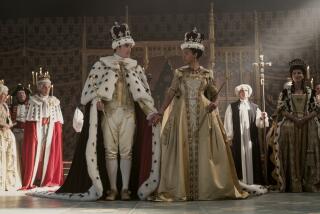Kew Palace reopening to public
- Share via
A Flemish merchant built it. Mad King George was confined to it. And Queen Victoria’s mother refused to live in it.
Now, for the first time in 10 years, you can visit Kew Palace when it reopens to the public Thursday after an $11.5-million renovation.
The red-brick palace, in Richmond’s Royal Botanic Gardens, is modest in size compared to royal haunts such as Kensington or Buckingham palaces. But for nearly a century, a succession of princely residents called the place home. Its most famous occupant was King George III, who ruled when the U.S. Colonies gained their independence from Britain.
Visitors touring Kew Palace today will hear his voice and those of his family and other residents in a radio play with actors discussing the royals’ interests and events that took place at Kew. The palace was the royal family’s summer home, a casual retreat from the formality of court life, from 1800 to 1810, after the king began to suffer bouts of what early 19th century doctors deemed madness and what scholar now believe was porphyria, a disease that can attack the nervous system. He died in 1820.
If George III and Queen Charlotte walked through the doors of the restored Kew Palace, they’d feel right at home. The elements of the palace they decorated in an early 19th century style have been preserved and restored -- bright green wallpapers and pink paint, a bold background for furniture and curtains in black, gold and red.
For the first time, the public will be allowed to visit the second floor of the house, which has been left virtually unchanged since George III’s family moved out nearly 200 years ago. The rooms are a time capsule of the family’s occupancy from 1803 to 1805.
George III had a wide range of interests, and exhibits reveal his fascination with art, science, astronomy and music. The king’s harpsichord is on display. Other family treasures include a dollhouse the princesses played with as children, King George IV’s silver baby rattle and the chair in which Queen Charlotte died. George III’s personal items on display include a shirt and waistcoat as well as a wax head cast during his lifetime by Madame Tussaud.
The initials of the house’s original owner, Samuel Fortrey, along with those of his wife, Catherine, are carved over the south door with the date 1631, the year the house was built. Built of Flemish bond brickwork and decorated with Dutch gables, the three-storied mansion was nicknamed the Dutch House.
The first royals to live in Kew Palace were the three oldest daughters of King George II in 1728. When Queen Victoria’s mother, the Dowager Duchess of Kent, was offered it as a residence in 1833, she said it was “an old house quite unfit for the princess and me to occupy, being very inadequate in accommodation and almost destitute of furniture.”
Queen Victoria opened Kew Palace to the public in 1899, but little was done to restore it then. The palace is the last royal residence in Kew. Others, such as Richmond Lodge and the White House, were demolished long ago. Their estates helped form the modern Royal Botanic Gardens.
Access to Kew Palace is through the Royal Botanic Gardens, and admission must be purchased for the gardens as well as the palace. Access to the gardens is about $17.50 for adults and free for children younger than 17; for Kew Palace, entry costs about $8.75 for adults and about $6.50 for children 5 to 16. Open 10 a.m. to 5:45 p.m. Tuesdays to Sundays. Information: Kew Palace, Royal Botanic Gardens Kew, Richmond, Surrey; 011-44-870-751-5179, www.hrp.org.uk.
More to Read
Sign up for The Wild
We’ll help you find the best places to hike, bike and run, as well as the perfect silent spots for meditation and yoga.
You may occasionally receive promotional content from the Los Angeles Times.






